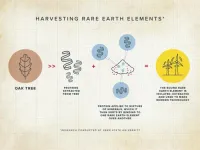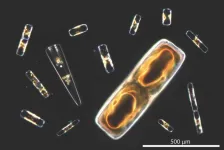(Press-News.org) Studies on the long-term consequences of COVID-19 (long-COVID) in patients with inflammatory rheumatic diseases (iRD) are scarce. Where available data do exist, they tend to be heterogeneous and largely inconclusive. In addition, it is not known whether correctly classifying patients with iRD as long-COVID cases is complicated by increased background noise due to the occurrence of persistent symptoms that could be attributed to either long-COVID or iRD.
A team in the Netherlands aimed to compare the risk of developing long-COVID after infection with the Omicron variant in iRD patients versus age- and sex-matched healthy controls. Data were collected from participants enrolled in a prospective cohort study. In line with WHO guidelines, long-COVID cases were defined as participants who reported persistent symptoms that lasted at least 8 weeks, started after the onset and within 3 months of a confirmed SARS-CoV-2 infection, and could not be explained by an alternative diagnosis.
A total of 1,974 iRD patients and 733 healthy controls participated, of whom 24% and 30% had an Omicron infection, respectively. Questionnaire data revealed that more patients compared to controls fulfilled long-COVID criteria; 21% versus 13% respectively – but this was attenuated after adjusting for potential confounders.
Post-hoc modelling showed that higher body mass index and worse severity in the acute infection phase were significantly associated with higher odds of developing long-COVID. Fatigue and loss of fitness were the most frequently reported symptoms of long-COVID in both groups, and recovery time from long-COVID was also similar.
Importantly, more iRD patients than healthy controls without a history of COVID-19 reported symptoms that are also observed in long-COVID; this could in part also be explained by clinical manifestations of underlying rheumatic diseases. Based on these findings, the authors concluded that people with iRD are not more susceptible to long-COVID than those in the general population.
In a session, COVID 19: A pandemic with a long tail, Ørbo and colleagues shared new data from Nor-vaC – a prospective cohort study that includes immune-mediated inflammatory disease (IMID) patients on immunosuppressive therapies.1 The group examined whether post-vaccination anti-Spike antibody levels were predictive of breakthrough infection and the clinical outcome of COVID-19.
To do this, they used data from 1,051 patients who provided post-vaccination samples and responded to follow-up questionnaires after three vaccine doses. Immunosuppressive medication included tumor necrosis factor inhibitors, methotrexate, interleukin inhibitors, janus kinase inhibitors, vedolizumab, and other medication. Hospital records, the Norwegian Patient Registry, and the Norwegian Death Cause Registry provided information on hospital admissions and cause of death.
Results showed that – while half of patients reported COVID-19 – few had life-threatening illness. Patients with the highest post-vaccination anti-Spike levels had a lower risk of COVID-19 infection, supporting the role of repeated vaccination in IMID patients on immunosuppressive therapies. The presence of comorbidities or ulcerative colitis increased the risk of breakthrough infections.
These results underline the good prognosis for Omicron infections in vaccinated IMID patients. Though it is possible that patients who knew they had low anti-Spike levels may have shielded during periods of high transmission, the absence of severe infections and deaths in this large cohort indicates that low antibody levels did not greatly increase risk of severe COVID-19.
Finally, Andreoli and colleagues report on the safety of COVID-19 vaccines during pregnancy and breastfeeding in women with autoimmune diseases, using data from 9,201 participants in the COVAD study. This international study in partnership with patient support groups focused on answering meaningful questions and addressing gaps in the literature about the uptake of COVID-19 vaccination in people living with autoimmune diseases.
Overall, 40 pregnant and 52 breastfeeding patients were identified, with vaccination rates of 100% and 96.2%, respectively. Adverse events of all severities were reported significantly more frequently by pregnant than non-pregnant patients, but there was no difference in comparison with pregnant healthy controls. There was also no difference observed between breastfeeding patients and healthy controls.
Post-vaccination disease flares were reported by 17.5% of pregnant and 20% of breastfeeding patients, and by 18% of age- and disease-matched control patients. All disease flares were managed with glucocorticoids, and one in five women required initiation or a change in their immunosuppressive treatment.
This study provides the first insights into the safety of COVID-19 vaccination during the antenatal period in women with autoimmune disease. While adverse events were more commonly reported by pregnant patients with autoimmune disease than those breastfeeding, these were no higher than among pregnant healthy controls without an autoimmune disease.
These observations are reassuring, and likely to strengthen physician-patient communication and overcome vaccine hesitancy. “The benefits for the mother and fetus by passive immunization are likely to overweigh the potential risks of adverse events and disease flares,” said Laura Andreoli from the University of Brescia in Italy.
Source:
Boekel L, et al. Patients with inflammatory rheumatic diseases are NOT at increased risk of long-COVID: data from a large prospective controlled cohort study. Presented at EULAR 2023; Abstract OP0078.
Ørbo H, et al. Incidence and clinical outcome of COVID-19 related to post-vaccination antibody levels in patients on immunosuppressive therapy: a prospective study in the Omicron era. Presented at EULAR 2023; Abstract OP0080.
Andreoli L, et al. COVID-19 Vaccine Safety during Pregnancy and Breastfeeding in Women with Autoimmune Diseases: Results from the COVAD Study. Presented at EULAR 2023; Abstract OP0082.
References:
1. Syversen SW, et al. Immunogenicity and Safety of Standard and Third-Dose SARS-CoV-2 Vaccination in Patients Receiving Immunosuppressive Therapy. Arthritis Rheumatol 2022;74(8):1321–32.
About EULAR
EULAR is the European umbrella organisation representing scientific societies, health professional associations and organisations for people with rheumatic and musculoskeletal diseases (RMDs). EULAR aims to reduce the impact of RMDs on individuals and society, as well as improve RMD treatments, prevention, and rehabilitation. To this end, EULAR fosters excellence in rheumatology education and research, promotes the translation of research advances into daily care, and advocates for the recognition of the needs of those living with RMDs by EU institutions.
Contact
EULAR Communications, communications@eular.org
Notes to Editors
EULAR Recommendations
EULAR School of Rheumatology
EULAR Press Releases
END
COVID and RA
New data presented at the EULAR 2023 Congress
2023-05-31
ELSE PRESS RELEASES FROM THIS DATE:
FMF: Factors associated with delayed diagnosis
2023-05-31
EULAR – The European Alliance of Associations for Rheumatology – held its 2023 annual congress in Milan, Italy. One of the abstracts chosen for presentation in the scientific session on Rheumatic and Musculoskeletal diseases (RMDs) in children and young people, focused on the factors associated with diagnostic delay in FMF, using data from the Juvenile Inflammatory Rheumatism (JIR) cohort.
Of 960 FMF patients enrolled, 80% received a diagnosis within 10 years of symptom onset; the remaining 20% had delayed diagnosis, and were significantly older with median age of 46.4 versus ...
Autoimmune diseases affect one in ten
2023-05-31
EULAR – the European Alliance of Associations for Rheumatology – works on a broad spectrum of autoimmune and auto-inflammatory diseases. A rise in the incidence of some of these has been described, raising the possibility that incidence might be impacted by environmental factors. But there is a lack of available data, and commonalities and differences between some individual diseases also remain poorly understood.
Conrad and colleagues aimed to clarify the picture by investigating 19 of the most common autoimmune diseases. Their work – shared at the 2023 EULAR congress in Milan, Italy – assesses trends over time, by sex, age, socioeconomic status, season ...
Exploring the role of AI in early RA
2023-05-31
Early inflammatory arthritis is often undifferentiated, but it may develop into established RA or another arthropathy.1 Alternatively, it may resolve spontaneously, or remain undifferentiated for indefinite periods. Erosion is a key prognostic factor which can be detected with magnetic resonance imaging (MRI).2 In addition, MRI allows direct visualization and assessment of (teno-) synovitis and bone marrow edema.3
Predicting early RA from MRI images of the hands and feet can help people access timely treatment, which may possibly ...
Smoking cessation and changes in anxiety, depression in adults with and without psychiatric disorders
2023-05-31
About The Study: In this study of 4,260 adults with and without psychiatric disorders, smoking cessation, sustained for at least 15 weeks, was associated with improved mental health outcomes in observational analyses, but the instrumental variable analysis provided inconclusive evidence. Findings like these may reassure people who smoke and their clinicians that smoking cessation likely will not worsen and may improve mental health.
Authors: Angela Difeng Wu, M.Sc., of the University of Oxford in Oxford, United Kingdom, is the corresponding author.
To access the embargoed study: Visit our For The Media website at this link https://media.jamanetwork.com/
(doi:10.1001/jamanetworkopen.2023.16111)
Editor’s ...
Landmark study finds that the shape of the brain influences the way it works
2023-05-31
For over a century, researchers have thought that the patterns of brain activity that define our experiences, hopes and dreams are determined by how different brain regions communicate with each other through a complex web of trillions of cellular connections.
Now, a study led by from researchers at Monash University's Turner Institute for Brain and Mental Health has examined more than 10,000 different maps of human brain activity and found that the overall shape of a person’s brain exerts a far greater influence on how we think, feel and behave than its intricate neuronal connectivity.
The study, published ...
New ‘designer’ titanium alloys made using 3D printing
2023-05-31
A team of researchers has created a new class of titanium alloys that are strong and not brittle under tension, by integrating alloy and 3D-printing process designs.
The breakthrough, published in the top journal Nature, could help extend the applications of titanium alloys, improve sustainability and drive innovative alloy design.
Their discovery holds promise for a new class of more sustainable high-performance titanium alloys for applications in aerospace, biomedical, chemical engineering, space and energy technologies.
RMIT University and the University of Sydney led the innovation, in collaboration with Hong Kong Polytechnic University and the company Hexagon Manufacturing Intelligence ...
A protein mines, sorts rare earths better than humans, paving way for green tech
2023-05-31
UNIVERSITY PARK, Pa. — Rare earth elements, like neodymium and dysprosium, are a critical component to almost all modern technologies, from smartphones to hard drives, but they are notoriously hard to separate from the Earth’s crust and from one another.
Penn State scientists have discovered a new mechanism by which bacteria can select between different rare earth elements, using the ability of a bacterial protein to bind to another unit of itself, or “dimerize,” when it is bound to certain rare earths, but prefer to remain a single unit, or “monomer,” ...
First-of-its-kind open-analysis platform for pediatric brain tumors provides robust data resource for childhood cancer research
2023-05-31
Philadelphia, May 31, 2023 – Researchers from Children’s Hospital of Philadelphia (CHOP), the Alex’s Lemonade Stand Foundation Childhood Cancer Data Lab, the Children’s Brain Tumor Network (CBTN), the Pacific Pediatric Neuro-Oncology Consortium (PNOC), and more than 20 additional institutions have partnered to create a first-of-its-kind open-source, reproducible analysis platform for pediatric brain tumors. With the help of thousands of genomically sequenced samples, researchers have used this platform to identify initial findings about genetic variants associated with poorer outcomes that could help guide future diagnostic and therapeutic advances.
The ...
Scientists’ report world’s first X-ray of a single atom in Nature
2023-05-31
A team of scientists from Ohio University, Argonne National Laboratory, the University of Illinois-Chicago, and others, led by Ohio University Professor of Physics, and Argonne National Laboratory scientist, Saw Wai Hla, have taken the world’s first X-ray SIGNAL (or SIGNATURE) of just one atom. This groundbreaking achievement was funded by the U.S. Department of Energy, Office of Basic Energy Sciences and could revolutionize the way scientists detect the materials.
Since its discovery by Roentgen ...
Phenomenal phytoplankton: Scientists uncover cellular process behind oxygen production
2023-05-31
Take a deep breath. Now take nine more. According to new research, the amount of oxygen in one of those 10 breaths was made possible thanks to a newly identified cellular mechanism that promotes photosynthesis in marine phytoplankton.
Described as “groundbreaking” by a team of researchers at UC San Diego’s Scripps Institution of Oceanography, this previously unknown process accounts for between 7% to 25% of all the oxygen produced and carbon fixed in the ocean. When also considering photosynthesis occuring on land, researchers estimated that this mechanism could be responsible for generating ...
LAST 30 PRESS RELEASES:
Injectable breast ‘implant’ offers alternative to traditional surgeries
Neuroscientists devise formulas to measure multilingualism
New prostate cancer trial seeks to reduce toxicity without sacrificing efficacy
Geometry shapes life
A CRISPR screen reveals many previously unrecognized genes required for brain development and a new neurodevelopmental disorder
Hot flush treatment has anti-breast cancer activity, study finds
Securing AI systems against growing cybersecurity threats
Longest observation of an active solar region
Why nail-biting, procrastination and other self-sabotaging behaviors are rooted in survival instincts
Regional variations in mechanical properties of porcine leptomeninges
Artificial empathy in therapy and healthcare: advancements in interpersonal interaction technologies
Why some brains switch gears more efficiently than others
UVA’s Jundong Li wins ICDM’S 2025 Tao Li Award for data mining, machine learning
UVA’s low-power, high-performance computer power player Mircea Stan earns National Academy of Inventors fellowship
Not playing by the rules: USU researcher explores filamentous algae dynamics in rivers
Do our body clocks influence our risk of dementia?
Anthropologists offer new evidence of bipedalism in long-debated fossil discovery
Safer receipt paper from wood
Dosage-sensitive genes suggest no whole-genome duplications in ancestral angiosperm
First ancient human herpesvirus genomes document their deep history with humans
Why Some Bacteria Survive Antibiotics and How to Stop Them - New study reveals that bacteria can survive antibiotic treatment through two fundamentally different “shutdown modes”
UCLA study links scar healing to dangerous placenta condition
CHANGE-seq-BE finds off-target changes in the genome from base editors
The Journal of Nuclear Medicine Ahead-of-Print Tip Sheet: January 2, 2026
Delayed or absent first dose of measles, mumps, and rubella vaccination
Trends in US preterm birth rates by household income and race and ethnicity
Study identifies potential biomarker linked to progression and brain inflammation in multiple sclerosis
Many mothers in Norway do not show up for postnatal check-ups
Researchers want to find out why quick clay is so unstable
Superradiant spins show teamwork at the quantum scale
[Press-News.org] COVID and RANew data presented at the EULAR 2023 Congress




